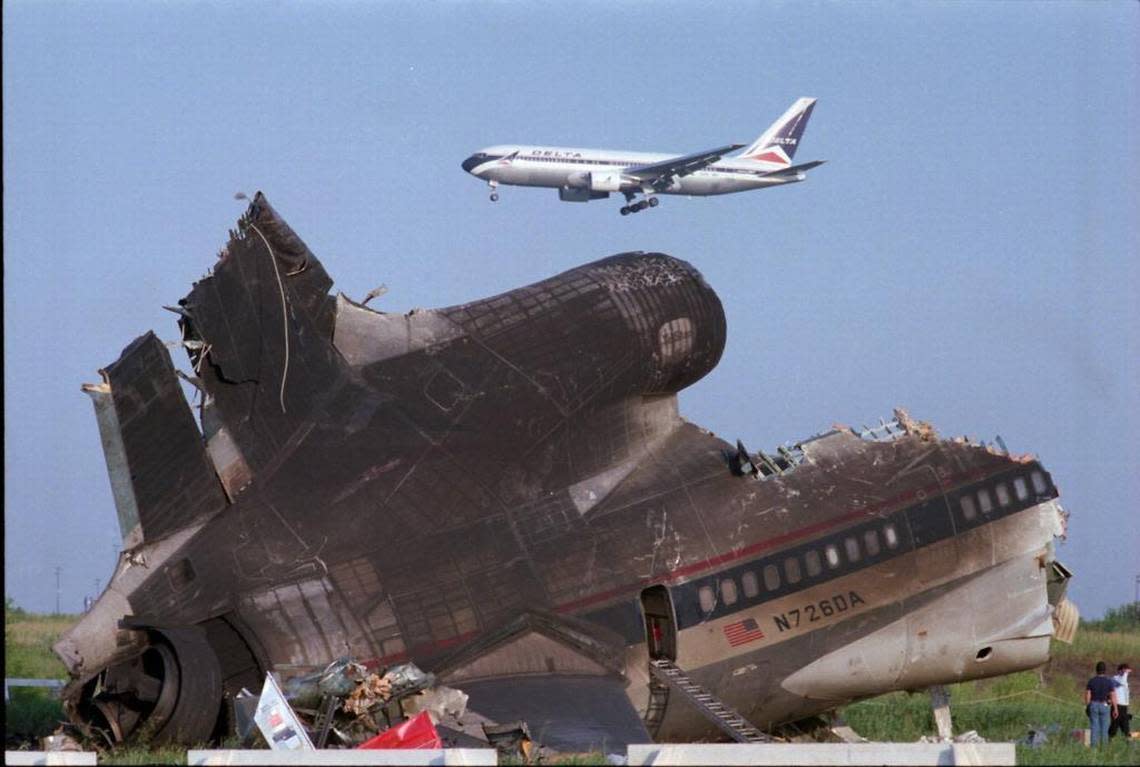List of the worst airplane crashes in Texas history by fatalities, cause
There have been 2,751 aircraft crashes with a fatality in Texas in more than 50 years, according to planecrashmap.com.
Last September, a Navy jet crashed into a Lake Worth neighborhood after a bird hit the engine. A military instructor and a student pilot were injured, and there was nearly $47 million in damages, according to documents obtained Tuesday by the Star-Telegram.
Here’s are some of the worst airplane crashes in Texas:
Delta Flight 191
On Aug. 2, 1985, around 6:05 p.m., the Delta Air Lines Flight 191 from Florida to Los Angeles with 163 people aboard crashed short of the runway at Dallas/Fort Worth International Airport and exploded. It killed 137 people and injured 26 others.
The event happened because of wind-shear from an intense thunderstorm downdraft that occurred at the north end of the airport, The National Transportation Safety Board’s accident board determined. Today we know this weather phenomenon as a microburst — strong downward winds that were not well understood at the time of the accident, according to the National Weather Service.
The accident was the third airplane crash in the United States between 1975 and 1985 where more than 100 people were killed due to a microburst. These crashes likely helped to drive the need to reform aviation weather safety, says NWS. These measures included better detecting dangerous weather using remote sensors, equipping pilots with tools to identify weather hazards and continuing collaboration between NWS and the Federal Aviation Administration.
Braniff Flight 352
It’s been 54 years since Braniff International Airways Flight 352 crashed after flying into a severe thunderstorm, killing all 80 passengers and five crew members who were en-route from Houston to Dallas. Among those killed was state Rep. Joseph Lockridge, Dallas’s first black state representative since Reconstruction.
“Probable Cause: The stressing of the aircraft structure beyond its ultimate strength during an attempted recovery from an unusual attitude induced by turbulence associated with a thunderstorm. The operation in the turbulence resulted from a decision to penetrate an area of known severe weather,” NTSB wrote in its final report issued on June 19, 1969.
This year, a state historical marker was placed across the road from the crash site.
“All of our lives have been touched by a tragic event but the friendships that have been made and endure will forever honor those that were lost on that fateful day,” Braniff Airways Foundation posted on its Facebook page following the installation.
American Airlines Flight 157
Twenty-eight of the 46 people aboard the American Airlines DC-6 passenger plane from New York City to Mexico City were killed after it crashed and burned at the north edge of Love Field in November of 1949. Three buildings were destroyed by the flames. Civil Aeronautics administration officials named it the worst air disaster in Texas history at the time.
After an engine failed, the pilot lost control of the plane. The cause was found to be: “The faulty execution of an engine-out approach.”
Delta Flight 1141
Delta Air Lines Flight 1141, a Boeing 727 flying between Dallas-Fort Worth and Salt Lake City on Aug. 31, 1988, crashed shortly after takeoff. Of the 108 on board, two crew members and 12 passengers were killed, and 76 were injured. All but one of the fatalities were due to smoke inhalation, medical examinations determined.
NTSB faulted the captain and co-pilot for the accident. In 1989, NTSB determined that there were two probable causes for the accident: inadequate cockpit discipline that resulted in the flight crew’s failure to extend the aircraft’s flaps and slats to proper take-off configuration, and failure of the takeoff configuration warning system to sound and alert the crew that the plane was not properly configured for takeoff.
Continental Express Flight 2574
Continental Express Flight 2574 crashed near Eagle Lake in September 1991 while initiating landing. All 11 passengers and three crew members on the Embraer 120 Brasilia aircraft were killed. The flight was heading from Laredo International Airport to George Bush Intercontinental Airport in Houston.
While there was speculation that a bomb was involved, the safety board discovered that missing screws on the horizontal stabilizer led to the crash.
“The failure of Continental Express maintenance and inspection personnel to adhere to proper maintenance and quality assurance procedures for the airplane’s horizontal stabilizer de-ice boots that led to the sudden in-flight loss of the partially secured left horizontal stabilizer leading edge and the immediate severe nose-down pitchover and breakup of the airplane,” NTSB said in its report. “Contributing to the cause of the accident was the failure of the Continental Express management to ensure compliance with the approved maintenance procedures, and the failure of FAA surveillance to detect and verify compliance with approved procedures.”
As a result of this and similar incidents, safety culture became the main topic at the U.S. National Summit on Transportation Safety, hosted by NTSB in 1997. That continued with the April 5, 2000 enactment of the Wendell H. Ford Aviation Investment and Reform Act for the 21st Century, which sought to improve airline safety.


